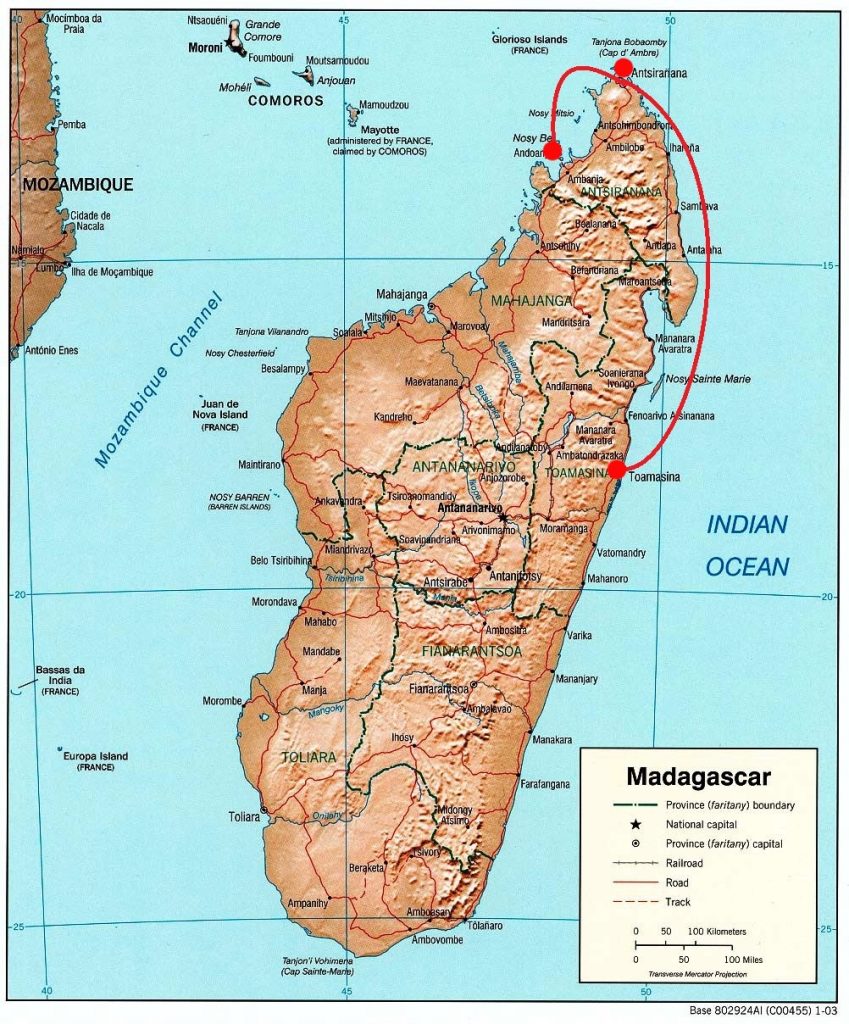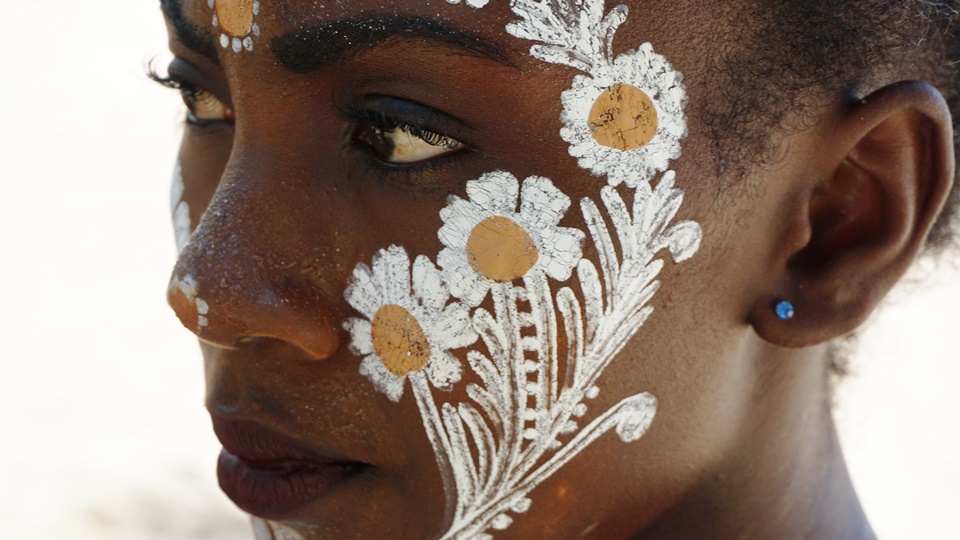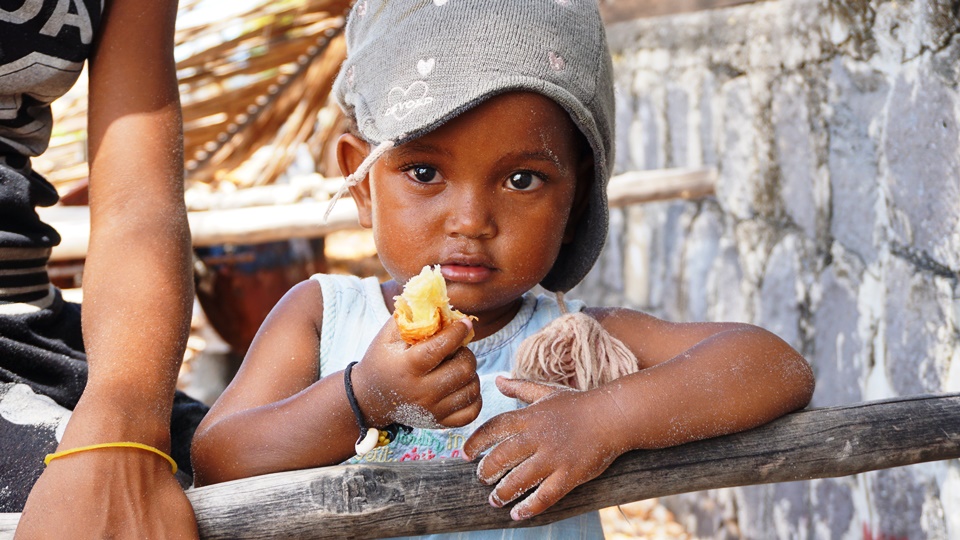Capital:
Antananarivo
Currency
Malagasy Ariary
Best time to visit:
Avoid the rainy season (November to March), when the heat is intense and travel can be difficult. The island is subject to cyclones from the end of December to the end of February. In the north, the climate is wetter than in the southern and western part of the island. The best time to visit is from July to October, when temperatures can drop below zero on the central plateau at night.
In a word:
Mora mora (slowly slowly)
Vaccines
Malaria exists throughout the country, especially in the coastal regions; antimalarial prophylaxis is recommended. Dengue is also present.
Warnings:
- Protect yourself from mosquito bites.
- Hospitals are short of drugs and equipment.
- Rabies is widespread: stay away from stray dogs.
- The circulation of unreliable and overcrowded vehicles and the presence of reckless drivers mean that the roads are potentially dangerous. Minimize risks by avoiding traveling at night.
At the table:
The Creole cuisine offers fish dishes as well as grilled meats (a local specialty is zebu). Rice forms the basis of every Malagasy meal, but foreigners can also order French fries or vegetables. As a dessert they offer koba ravina (steamed bundles of banana pulp), flambé babane and troical fruit.


Essential experiences:
Playing with the lemurs in the Ivoloina Park in Tamatave; Sailing in the clear waters of Nosy Be by catamaran; Explore the lush rainforest of the Ranomafana National Park
The "Big Island", Madagascar, is the fourth largest island in the world, a wild, simple and primitive land, one of the last intact lands that separated from Africa starting about one hundred and sixty million millions of years ago until you reach the current position. island synonymous with escape, fascinating wild land, land of happiness. The inhabitants will welcome you with a tonga soa, that is "welcome". Unspoiled nature, lemurs jumping on the trees and a humble people ready to welcome you and tell you their story.
Madagascar is among the ecologically richest countries on the planet for the uncontaminated flora and the fauna that includes rare species. Think about living here 90% of the known lemurs and half of the world's chameleons, 120 varieties of palms, 7 of baobabs, over 600 of medicinal plants. By tradition, the Malagasy do not consider themselves owners of the land (which they consider entrusted to them by the gods), but custodians and responsible for its preservation for future generations.
In this journey we have only touched three ports in the north of the country, reserving the possibility of a future journey in the hinterland very soon. Here is our experience!
Nosy Be from the Malagasy "great island" is precisely this, a very large island on the northwestern coast of Madagascar, in the Mozambique channel. Here you will find volcanic lakes, lazy lemurs, rum distilleries and intricate coral reefs that practically beg to be explored. Lovers of flora and fauna will feel in seventh heaven in the beautiful natural reserve of Lokobe.
Nosy Be has been nicknamed the perfume island due to the cultivation of ylang ylang, graviola, coffee, vanilla, cinnamon, cocoa and many other fragrant plants.
We take a van directly from the port of Hell Ville direct towards the north end of the island but, after a few meters, we remain bottled up in a chaotic traffic and take the opportunity to observe the daily local life pass before our eyes!
Along the way we stop at the Ambondrona Waterfall ... we pass through numerous small villages and, each time, small groups of children approached loudly to receive some toy or notebook we had brought for the occasion.
Finally we reach Andilana Beach: here we find a postcard landscape and a pristine sea, with clear water and a fine white beach that looks like talc.













What can we taste in Madagascar? The typical dishes are the ravitoto (a stew with cassava sprouts and pieces of zebu or pork), the mosakiky (meat skewers accompanied by mango cut into thin strips or potatoes) and betsabetsa, an alcoholic beverage made from sugar cane . Irresistible tastings in the markets, but beware of unwashed fruit and vegetables and exotic foods to which the body is not used. The tour of the Hell Ville market makes us appreciate this land even more!
After two days of sailing we arrive in the bay of Diego Suarez, today known as Ansiranana.
Third Malagasy port and the largest island in northern Madagascar.
Diégo-Suarez is also a joyous meeting point of different origins: Comorians, Chinese, Indians and Europeans live together peacefully.
We negotiate a van for the beach of Abakao and cross much of the area having the opportunity to admire this wonderful land.
Everything is exciting: the numerous rivers like pulsating veins, flow downstream, green hills and houses of straw and bricks, long slopes of red earth, where carts pulled by zebus help men to transport food and goods and the environment made of bush spinosa e di savana where, from time to time, some suggestive baobabs appear that help make this background even more magical!
Antsiranana, which in ancient times was a refuge for pirates, today is a true natural paradise even if, for us, the beach of Nosy Be continues to hold a higher place in the ranking of the most beautiful ones. The Emerald Sea, its beaches of fine sand and its bays offer wonderful views of the coral reef. The wild nature of the bays of the Dunes, of the Pigeons or of Sakalava, can be explored on foot or by mountain bike.
Fortunately tourism has not yet set foot in such a massive and imposing way, it is enough to start with a bit of adventure and let yourself be carried away by the motto of the town: "mora mora" (slowly)!














Tamatave or Toamasina, which in Malagasy meant "is salty", is the second largest city on the island after its capital. It stretches between an immense beach that runs along the Indian Ocean and the Ivondro bay. Once a pirate settlement, the town of Tamatave has become the country's main port as well as a major exporter. Coffee, vanilla, cloves and other spices leave from here for distant lands ...
Tamatave is cosmopolitan: the most numerous ethnic group, that of the betsinisaraka, coexists with a vast Chinese, Indo-Pakistani and even some European community.
We were lucky enough to stay in place in November, so we enjoyed the frenzy of "Any letchi e", the opening of the tasty litchi campaign, everywhere they sold this delicious fruit!
The city and its great straight avenues are marked by the colonial past. The ancient colonnaded buildings and street names have remained unchanged. The heart of Tamatave is Place Bien Aimé, where the banyan were planted respecting Malagasy astrology. In this old neighborhood, Creole houses have the distinction of being built on stilts to protect themselves from the dampness of the ground. The market and the port are always very animated!
The avenue of Independence is very picturesque, where there is a statue of the goddess of the South seas.
The "heart" of the city is located in the Bien Aimé square, famous for its age-old plants arranged according to the Malagasy astrological signs. In these neighborhoods of the old Tamatave are concentrated Creole houses built on stilts to protect themselves from the humidity of the ground.
When we travel to countries less fortunate than ours, we always try to carve out some time to give to others. We often visit local orphanages bringing more things from Italy for them; when time is running out a jump in a school can never be absent ... and now that we have a child traveling with us the concepts of "sharing" and "solidarity" become even more important.








Here you should not miss a visit to the Ivoloina park, which ensures the protection of the lemurs and their reintegration into the natural environment.
Honestly I expected to see many more specimens of this typical Madagascar animal, especially reading our guide; in reality there are relatively few, even if of many different types.
Madagascar is neither Africa nor East, although both of them preserve traditions and culture: after rowing on simple pirogues, the populations coming from Indonesia and from the African coasts stopped in this piece of land and contributed to the formation of a mosaic of 18 ethnic groups. They are and feel proudly Creoles!
With the project to return soon to this wonderful land we set sail from the port of Tamatave heading towards a totally different island: Reunion! We will be back soon to explore and discover its most alive hinterland!
See you soon dear Madagascar!








Error: No feed found.
Please go to the Instagram Feed settings page to create a feed.
2 Responses
Madagascar est la grande île de l’Ocean Indien. Légèrement plus grande que la France qui , avec l’Ukraine Crimée comprise, est le deuxième plus grand pays d’Europe…
C’est dire la grandeur de Madagascar qui possède donc beaucoup de diversité. C’est une île d’aventure hors des sentiers battus si l’on se donne la peine de rechercher son authenticité
Merci dear Manoj, it’s always so great and interesting to hear and read your comments